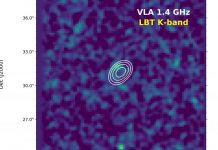
While analyzing observations of the distant universe captured by the Atacama Large Millimeter Array, or ALMA, a collection of 66 telescopes in Chile’s high desert, scientists spotted a faint blob. Like a ghost, the unexpected glow appeared unconnected to any major cosmic structure.
“It was very mysterious because the light seemed not to be linked to any known galaxy at all,” lead researcher Christina Williams, an astronomer at the University of Arizona, said in a news release.
“When I saw this galaxy was invisible at any other wavelength, I got really excited because it meant that it was probably really far away and hidden by clouds of dust.”
Analysis of the faint glow suggests the emissions originated from 12.5 billion light-years away. The mysterious wavelengths reveal the universe as it was just 1.3 billion years after the Big Bang.
The light picked up by ALMA isn’t the glow of stars in the early universe, but of ancient cosmic dust warmed by the energy of star formation deep inside the distant galaxy. These layers of dust work like an invisibility cloak, keeping the monstrous galaxy nearly undetectable.
“We figured out that the galaxy is actually a massive monster galaxy with as many stars as our Milky Way, but brimming with activity, forming new stars at 100 times the rate of our own galaxy,” said Ivo Labbé, of the Swinburne University of Technology in Australia.
In order to understand how and why the universe came to look and behave as it does today, scientists have long sought to document the earliest days of galaxy formation and evolution. Previous observations suggest some galaxies in the early universe formed and grew to tremendous sizes surprisingly quickly. But scientists have struggled to account for these observations with their cosmological models.
For one, scientists studying the early universe have only spotted massive, already matured galaxies, not proto-galaxies or newly formed ones. None of the small galaxies found in the distant universe show signs of growth that might explain these massive galaxies.
“Our hidden monster galaxy has precisely the right ingredients to be that missing link, because they are probably a lot more common,” said Williams, a National Science Foundation postdoctoral fellow at the Steward Observatory.
Scientists described the invisible monster this week in the Astrophysical Journal. Authors of the study suspect there are more giant galaxies lurking in the early universe.
“These otherwise hidden galaxies are truly intriguing; it makes you wonder if this is just the tip of the iceberg, with a whole new type of galaxy population just waiting to be discovered,” said Kate Whitaker, assistant professor at the University of Massachusetts, Amherst.
Astronomers expect their hiding spots will be revealed by more powerful telescopes, like NASA’s James Webb Space Telescope, in the near future.
“Right now we are eager for the James Webb Space Telescope to take a look at these things,” Williams said. “JWST will be able to look through the dust veil so we can learn how big these galaxies really are and how fast they are growing, to better understand why models fail in explaining them.”





